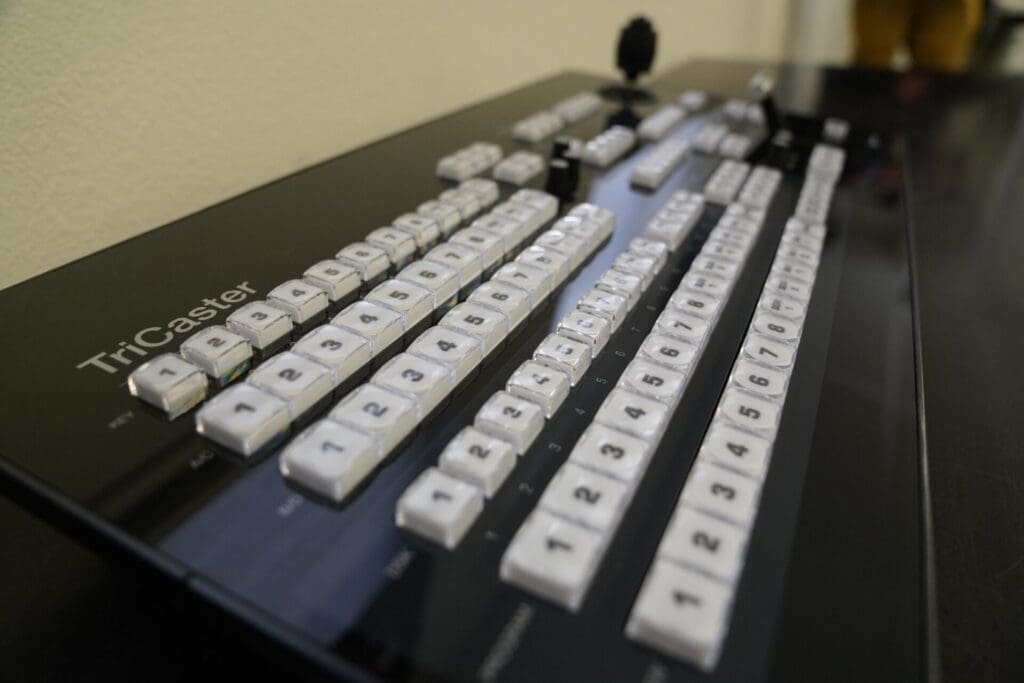Throughout the pandemic, we saw an increase in everything virtual: conferences, graduations, sporting events and more. In order to meet the new demands of this virtual reality, we needed a system that could scale easily to meet the needs of any production. This is where the NewTek line of products and NDI come in.
What is NewTek?

NewTek has been a leader in the broadcasting industry ever since the release of the first TriCaster in 2005. With the TriCaster you could control everything you needed for a live broadcast, including video feeds, virtual sets, broadcast graphics and much more. We found it extremely useful over the past few years as we have developed our broadcasting workflow. We use the NewTek Tricaster, 3Play, Talk-show, and Flowics for our productions which are held together through NDI.
NewTek is currently a subsidiary of VIZRT Group who states their single guiding purpose is “more stories, better told” through “supplying media content creators around the world with software-defined visual storytelling tools”. (https://www.vizrtgroup.com/about/) The acquisition was announced in a press release on April 1, 2019 stating “the goal is to make it possible for people to tell their story using video, whether they are a kid in a classroom or a tier-1 broadcaster”. (https://www.newtek.com/press-releases/vizrt-acquires-newtek/)
Their philosophy of “more stories, better told” aligns with our core values of “telling your stories to inspire others”. Our goal is to make each product the best production we have done yet, each and every time. With the support of NewTek’s ecosystem and constantly developing NDI technology, we have been able to continually increase our production capabilities.
A Brief History on NDI
NewTek was the leader in developing the Network Device Interface or NDI, which is “a high-performance standard that allows anyone to use real time, ultra-low latency video on existing IP video networks” (https://www.ndi.tv/about-ndi/). This allowed different hardware like the TriCaster and production cameras to be connected via the Internet. With an NDI connection any device on the network could see the NDI input and use its data stream, in the case of a camera it would be a live video stream. Gone are the days where every input and output need to be connected via SDI.
The first release of NDI was in 2015 where NewTek announced it was releasing the protocol as an “open source protocol for live production IP workflows”.
(http://web.archive.org/web/20150911083228/http://www.newtek.com:80/news-events/newsroom/press-releases/1281-newtek-announces-ndi-open-protocol-for-ip-production-workflow.html) With NDI being open source, this allowed manufacturers and developers alike to build on its pre-existing structure to meet the needs of the industry. Additionally, an open-source protocol helped the adoption of this new technology throughout the industry because you no longer needed to buy a specific manufacturers’ equipment, rather you could choose from your favorite gear with the only limitation being NDI support. Today many manufacturers are moving towards NDI being the main connection for data transfer, replacing the legacy standards of HDMI and SDI. Major players like SONY, Panasonic, LiveU, and Teradek have adopted NDI as the primary transfer protocol.
Over the years NDI has received massive updates allowing for new features and creative workflows within the environment itself. Notable changes to NDI occurred in version 3.0, 4.0 and 5.0 released in 2017, 2019 and 2021 respectively.
| NDI Version | Notable Changes |
|---|---|
| 3.0 | Long Distance Transmission PTZ Camera Control NDI | HX |
| 4.0 | High Quality ISOs |
| 5.0 | NDI | HX 2.0 NDI Bridge Higher Quality less bandwidth |
NDI|HX
With the release of NDI|HX (high efficiency) the new H.264 encoding was used to lower the required bandwidth for data transmission. This allowed for NDI|HX to be used over WiFi and slower internet connections. One 1920×1080 video stream at 30 frames per second requires 125 Mbps over NDI and only 20 Mbps over NDI|HX.
| Bandwidth to stream one 1920 x 1080 video at 30 fps | Megabits per Second |
|---|---|
| NDI | 125 Mbps |
| NDI | HX | 20 Mbps |
With NDI|HX you could have 6 video streams and still use less bandwidth than one NDI stream! This was a major update, and one they have continually improved upon with NDI|HX 2.0.
NDI Bridge
The NDI Bridge is one of the newest additions to the capabilities of NDI. It allows users to “securely share NDI sources between local or remote sites, anywhere in the world” (https://www.ndi.tv/tools/bridge/). With this new feature the entire connected world can become your studio. Over the bridge the signal includes Alpha channel, PTZ control, Tally, Metadata, KVM and more. With the alpha channel transmitted over NDI, custom graphics with transparent backgrounds can be used throughout production. Remote PTZ control over the bridge allows remote operators to control the PTZ from anywhere further allowing worldwide collaboration. This is taken one step further by KVM transfer, again allowing one workstation to control the production from anywhere. The NDI Bridge truly brings the power of broadcasting to anyone with internet connection. It also can transcode signals between NDI and NDI|HX keeping its footprint on the network as low as possible.
NDI and Us
Within our studio, we use the NewTek TriCaster, 3Play, and Talk-Show hardware providing us with the challenge of connecting them all for a cohesive broadcast environment. One of the main challenges with using various pieces of hardware for a live production is how to connect everything. The TriCaster only has so many physical inputs and outputs that we would have to pick and choose which elements were necessary for each production. This poses a large issue with limiting the size of production.

Knowing that the hardware is limited to 4 inputs, that immediately limits the amount of camera feeds you can take in. This also locks the production into using the four camera feeds throughout the whole show. The larger the production the more difficult it is to allocate resources to the appropriate places while still attempting to have enough coverage for the drama of live events. One of the best parts about broadcasting live events is when something unexpected happens and the broadcast captures it when it happens. With NDI tool we can set up a new camera feed and have it live through our workflow quicker than SDI allowing up to modify our set up to capture what we need. When we did a broadcast during the pandemic, we had two anchors sitting on separate sides of our studio for social distancing but on screen we were able to put them together on a virtual set. Viewers were concerned with the safety of the production but through NDI we were able to set up a new camera feed that captured the anchors sitting apart to show the viewers. Through NDI we were able to modify our production on a whim to accommodate our audience. We also are able to set up a new live camera feed on the ground with our mobile broadcasting hardware and include it in our production. An example of this was during one of our IRONMAN World Championship Broadcasts where we set up a new camera feed to capture the finisher podium for the broadcast. Having the capability to modify our workflow and input streams through NDI gives us more chances to catch those unexpected or story-telling events that happen during a broadcast. For example, with NDI we are able to dynamically adjust our production size allowing for an appropriate scale to match the production.
As we incorporated NDI into our workflow, we found it helped mitigate the continual decisions of what was needed and what we could afford to connect for each production. Through NDI, we were able to connect everything all the time and created the possibility for new elements to be incorporated into our workflow, growing the creativity of the team and encouraging development of our productions.
Conclusion
NDI provided us with new capabilities and continues to improve upon itself. When we first started using NDI, we were able to clean up our studio and create more inputs for our limited hardware. As we have grown, and the protocol has changed, we are able to scale our productions to meet the needs of our clients. Through NDI we are able maneuver through the everchanging landscape of broadcasting with ease. These aspects of NDI align with one of our core values, collaboration which makes it a cornerstone in our workflow.
